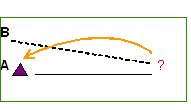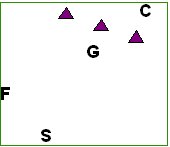COLLECTIVE SPORTS
UNIT: CRICKET
LESSON: 1
Contents:
FIELDING, CATCHING AND THROWINGAPPARATUS: Tennis balls, markers/cones/wickets, bats, hoops.
ORGANISATION
CONTENT
TEACHING POINTS
In twos: feeder and striker.
In a designated area with hoop and three cones.

S= striker
F= fielder
WARM UP
1- Hit and catch
Children work in pairs. One is the feeder and the other the striker. Between them there is a hoop. The feeder throws the ball from closest position and the striker hits it back. Before hitting, the ball has to bounce in the hoop. It means that the feeder throws the ball in a way that it bounces in the hoop, then; the striker hits the ball back and the feeder has to try to catch it.
After three successful strikes, the feeder moves back to next position (each position is marked with the cones). Can the feeder catch the ball in new positions?
Change after ten strikes.
It is good to try this game with different types of bats.
How to improve
-Watch the path of the ball.
-Try to move to the best striking position as the ball comes towards you.
-Stand still to strike
Challenges and changes
- How many times can you hit the ball without missing?
- Can you feed the ball into the hoop each time?
- Can you guess where the ball will be hit?
Easier
• Stand closer to the hoop.
• Use a larger ball.
• Use a bat with a bigger striking area.
Harder
• Move further from the hoop.
• Use a smaller ball.

MAIN PART:
Skills; fielding
2- Throw the ball 1 :
Children work in partners. A stands behind the marker and rolls the ball gently towards partner B who is standing 10m-15m away. B runs towards the ball, scoops and throws underarm to their partner at about waist height. A and B then change roles.
Right handed fielders should pick up the ball with right foot alongside the ball. Conversely with left handers. (Children could start with stationary ball).
Work in pairs.

3- Throw the ball 2:
Children work in partners. A stands behind the marker and B stands to the side of A. A rolls the ball out and B chases, picks up the ball , turns and throws to A. Then A and B change roles.
Right handed fielders should pick up the ball so that they can turn without losing their balance as should left handers . Hands should face backwards as the ball is picked up and knees should be bent. Aim by pointing non-throwing arm at partner and throwing overarm to partner's hands.

Skills; catching and throwing
4- Close catching
Children work in partners, facing each other, 3m apart. A throws the ball underarm. B catches the ball with two hands, if possible. They then change roles.
Underarm throws can be gradually increasing difficulty by throwing to right and left of partner.

5 - Catching the high ball.
Children work in partners, facing each other 10m apart. A throws the ball high to B who uses upward cradle if ball drops in front or the Australian method if the ball arrives at/above chest height. (Australian method – thumbs together, fingers pointing up)

6- Run and catching the high ball:
Children are in partners, facing each other 10m-15m apart. A throws the ball high so that the ball should drop between A and B. B has to run forward to catch it before it hits the floor. The same catching method as the previous activity is used.

7- Run and catching the high ball (variation):

GAME; NON – STOP CRICKET
8- 6 v 6 games
Children are divided in groups of 6 in order to play a 6 versus 6 cricket game.
RULES:
• Bowler should bowl underarm,
• If batter hits it he/she must run around the cone and back to wicket.
• Fielders must get ball back to the bowler as soon as possible who bowls immediately whether the batsman is back or not.
• The batter can be out if bowled hits wicket or if fielders catch the ball or caught. In this case, another batter from the team hits the ball. When all the batters are out, the two teams change roles.
• Each time the batter runs around cone and back to the wicket his/her team score one run.
• The bowler must be in hoop when bowling.